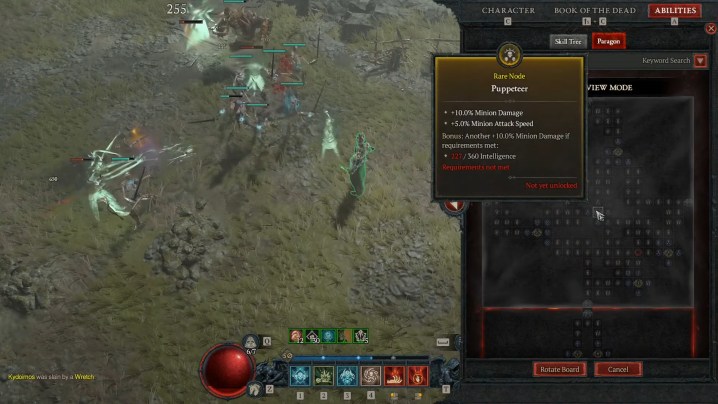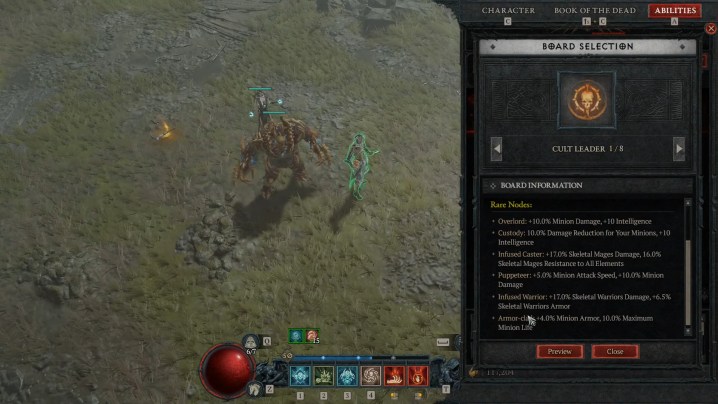Despite how deep your character builds can get in Diablo 4, the game does a decent job of slowly dishing out its mechanics and complexities over time. You start out gaining levels as expected, then are introduced to the Renown system, and not much else to confuse you for quite a while. Once you hit level 50, the game throws out another layer of complexity, this one far more confusing and intimidating than the others called the Paragon Board. If you’re new to Diablo, seeing this new system will almost certainly overwhelm you. However, understanding and taking full advantage of it is essential if you expect to keep up with the end-game content. Don’t get stun-locked by this massive system and let us show you exactly how the Paragon Board works in Diablo 4.
What is the Paragon Board?

In short, the Paragon Board is how you can keep strengthening your character beyond the level cap in Diablo 4. Once you hit level 50, alongside traditional XP, you will start to accumulate what is known as Paragon Points to spend on the board. Each point can be used to unlock a node on the board that grants your character some associated buff or bonus.
Just like there isn’t enough XP to max out every skill for your class in Diablo 4, there is a limit on Paragon Points that keep you from getting everything on the board. So, just like when designing your class’s build, you will need to choose carefully which nodes you want to invest your points into. You can earn a maximum of 200 Paragon Points, with four earned for every level above 50 you gain.
How the Paragon Board works

The Paragon Board looks a little bit like a Sphere Grid or massive skill tree and functions much the same. Your board will be filled with different node types that, when you unlock them with a Paragon Point, grant a different buff.
- Strength: Increases armor
- Intelligence: Increases damage and resistance to elements
- Willpower: Increases resource generation, healing, and overpower
- Dexterity: Increases dodge chance and critical hit chance
Now, to complicate things even more, these nodes are also color-coded. You can think of these like the rarity system.
- Grey Nodes: Give +5 to the related stat
- Blue Nodes: Grant unique benefits, such as elemental resistances or cooldowns
- Gold Notes: These give two bonuses that can be found in Grey and Blue Nodes, plus a bonus buff that has a stat requirement to receive
- Orange Nodes: Found in the very center of the board, these nodes give a class-specific bonus
As you invest and move across the Paragon Board, you will find Board Attachment Gates at the edges. Not only does this give you +5 to all stats for unlocking it, but it also unlocks a second Paragon Board attached to that point for you to continue investing points into. Once you unlock a gate, you will get to pick one of eight new boards to pick depending on which class you’re playing which have different layouts and numbers of rare nodes. You’re also free to rotate the board before placing it to get to the nodes you want faster.
How Paragon Glyphs work

If all that wasn’t enough, you’ll also need to worry about Sockets and Paragon Glyphs on your boards. Sockets are unique spots on your Paragon Board that can only be unlocked using a Paragon Glyph, which you don’t earn from leveling up like Paragon Points. Instead, Glyphs are drops you need to collect during gameplay. This is worth the effort because each Glyph will impact the effect of a number of nearby nodes. For example, one may have a radius of three nodes that all gain a +15% bonus to non-physical and damage reduction modifiers, or a simple +30% bonus to all nodes depending on the level of the Glyph.
While Paragon Glyphs are technically random drops (which will only start appearing after you’ve unlocked the Paragon Board), they do tend to have a better chance of dropping from higher-tier enemies and chests. Nightmare Dungeons are the best place to get them not only because they are home to many of these elite enemies and rare chests, but also for the second mechanic.
Leveling up a Glyph to increase its range and improve its bonuses also is done through Nightmare Dungeons. By finishing a Nightmare Dungeon, you can interact with an Awakened Glyphstone in the boss room to transfer XP into any of your Glyphs to level it up.
Editors’ Recommendations
Stay connected with us on social media platform for instant update click here to join our Twitter, & Facebook
We are now on Telegram. Click here to join our channel (@TechiUpdate) and stay updated with the latest Technology headlines.
For all the latest Gaming News Click Here
